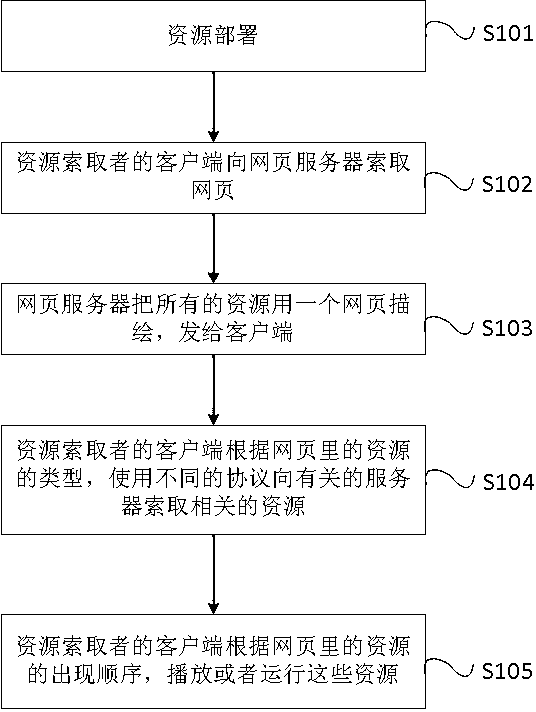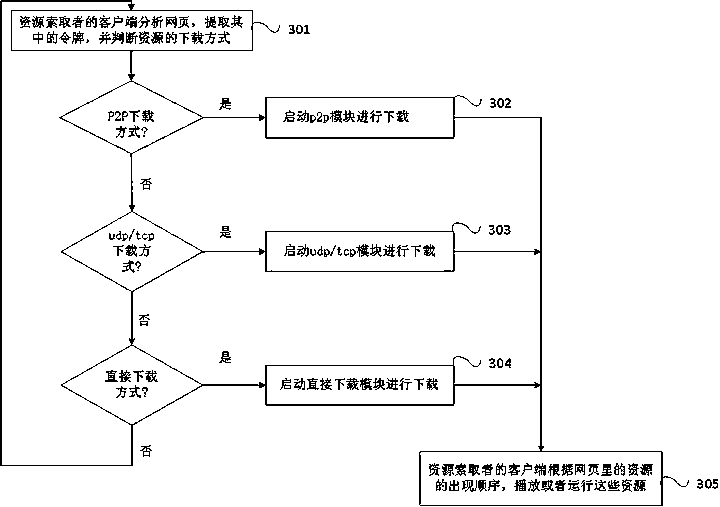P2P content distribution system of promiscuous mode
A hybrid mode and distribution system technology, applied in the transmission system, electrical components, etc., can solve problems such as long loading time, unstable connection, slow resource startup, etc., to reduce load, save resource bandwidth consumption, and ensure user experience.
- Summary
- Abstract
- Description
- Claims
- Application Information
AI Technical Summary
Problems solved by technology
Method used
Image
Examples
Embodiment 1
[0038] An overview of the entire implementation process can be found in figure 1 . This schematic diagram illustrates the entire process, although for the background server, subsystems supporting different protocols need to be equipped separately. But for users, the client working in promiscuous mode handles all the details and hides the differences between different protocols, achieving the same effect as traditional web pages using public protocols ( http, https ) to download resources. Most importantly, by introducing p2p technology, the bandwidth consumption of other servers is greatly reduced, which is the core technology of the present invention.
[0039] First deploy resources such as figure 2 As mentioned above, the deployment of resources is determined according to factors such as the playing time or running time of each resource, the playing or running sequence, the size of the resource, the type of the resource, and the specific use of the resource. The resourc...
Embodiment 2
[0047] According to an embodiment of the present invention, the workflow of the p2p download wherein is described in detail, such as Figure 4 As shown, the process includes the following steps:
[0048] Step 401, the client connects to the control server by virtue of the token extracted from the webpage, and asks the control server for other p2p peer-to-peer device identifiers.
[0049] Step 402, the client interface module of the control server at first verifies the identity of the user, and if it passes the verification, the state machine module is called to resolve the user's request, and the state machine module first extracts the characteristics of the user: the city where the user is located, the NAT network type of the user, The user's owned resource segment and the user's bandwidth estimate are searched for other matching resource requesters and P2P resource providers in the existing state table, and then the peer device identifiers of these nodes are sent to the clie...
Embodiment 3
[0058] According to an embodiment of the present invention, a method embodiment for dynamically jumping to product information during playback is also provided. When the resource requester's client is playing or running certain webpages, some webpage elements will display the serial number of some commodities. If the user enters the serial number of a certain commodity through the client, the client will jump to the website of the commodity. The web page plays the information of the product; after the playback is completed, it continues to play or run the resource that was interrupted just now.
[0059] Specific steps such as Figure 5 Shown:
[0060] Step 501: The user inputs the serial number of the commodity through the menu option of the client terminal.
PUM
 Login to View More
Login to View More Abstract
Description
Claims
Application Information
 Login to View More
Login to View More - Generate Ideas
- Intellectual Property
- Life Sciences
- Materials
- Tech Scout
- Unparalleled Data Quality
- Higher Quality Content
- 60% Fewer Hallucinations
Browse by: Latest US Patents, China's latest patents, Technical Efficacy Thesaurus, Application Domain, Technology Topic, Popular Technical Reports.
© 2025 PatSnap. All rights reserved.Legal|Privacy policy|Modern Slavery Act Transparency Statement|Sitemap|About US| Contact US: help@patsnap.com



